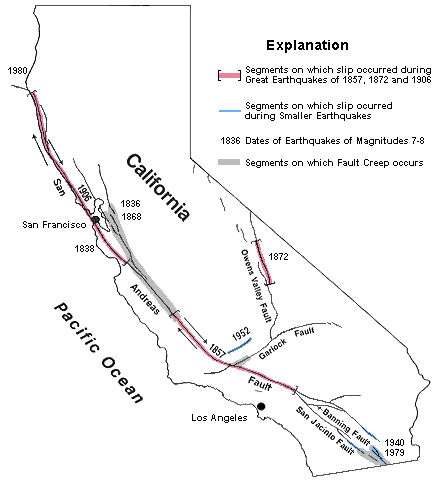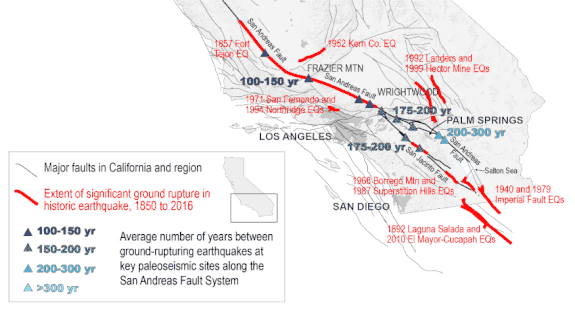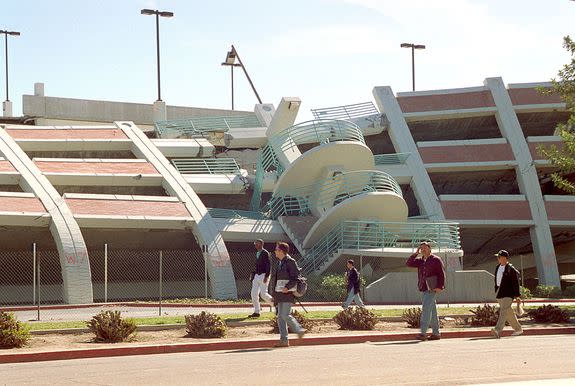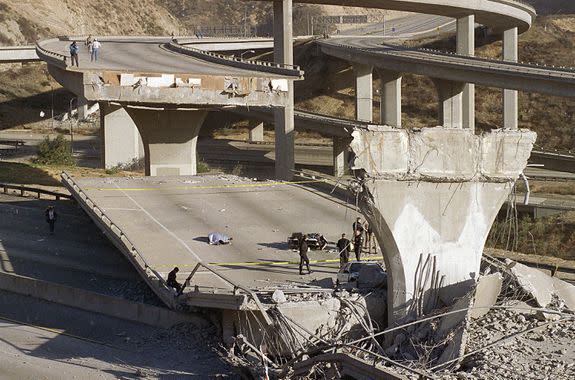4 things to know about California's strange earthquake drought

What's up in earthquake country?
A compelling new report authored by two U.S. Geological Survey (USGS) researchers found that three powerful California faults have been strangely — almost impossibly — quiet for the last 100 years. Digging into the soil around these faults, Glenn Biasi and Kate Scharer found that big, ground-rupturing earthquakes have been a regular occurrence in the temblor-prone land over the last 1000 years.
That's what makes the last 100 years so unusual.
"We should not see gaps of 100 years," Biasi said.
This study, published in Seismological Research Letters, is valuable to consider, not just for what it says about the region's past, but what it could mean for California's shaky future. Here are the big takeaways.
1. Expect the next century to be...busier
While scientists cannot predict earthquakes, records of past temblors (preserved by transformation and changes in the ground) give researchers like Biasi a coherent understanding of how faults generally behave. Three of California's most important faults — the San Andreas, San Jacinto, and Hayward — carry most of the Golden State's load as they separate the massive Pacific plate from the great North American plate. These colossal slabs of Earth's crust are incessantly pushing and sliding against one another.
At some point, something has to give.
In the years between 1800 and 1918, there was a lot of give, with eight big, ground-rupturing quakes preserved in the geologic record. The most famous of these temblors, the infamous 1906 San Francisco quake, dramatically thrust the ground forward some 20 feet.
Now, after years of quietude, the pressure is building along these faults.
"It's reasonable that if there’s a long quiescence we would expect a higher rate for the next 100 years," said John Vidale, a seismologist and former director of the Southern California Earthquake Center.

Image: usgs
It's unknown just how many more big quakes (of magnitude 6.5 or higher) might occur this century. But it's unwise to ignore the averages of past quaking activity. There's been three or four per century. So after the recent century of quiet, there may be a bit more action.
"The next century has to be busier than the last one," said Biasi. "Our studies suggest that those probabilities are somewhat higher."
2. But we're not on the verge of an earthquake storm
Although it only takes one terrible quake to traumatize a region, the lack of big quakes over the last 100 years doesn't mean there's a looming flurry of violent temblors.
"We’re not on the verge of some earthquake storm in the next couple years," said Vidale. When faults have been quiet for some time, the risk for movement on a fault or section of a fault might double, at most, he explained. But it's not as if everything is now ready to blow.

Image: Kate Scharer / USGS
"It's not that [the odds of a quake] skyrocket," said Vidale. "The danger might be doubled — but not everything is overdue. It's not 10-months pregnant."
SEE ALSO: The West accepts its drought-ridden future, slashes water use
A still unknown circumstance hiding beneath the ground may be responsible for the quiet along California's weighty faults, noted Biasi. The exceptional odds of such a quiet 100-year-period happening — which came out to the extremely low odds of just 0.3 percent according to their models — isn't some rare, statistical accident, emphasized Biasi. There may be some geologic events, or organization, transpiring below ground and slowing or suspending California's big faults. "It's more likely there's some organizing influence at work," he said, noting that the busy quake activity in the preceding century may have changed or triggered something, like a freeway accident causing a pileup, and now the road ahead is unusually (and temporarily) empty.
"It may be that the organization is due to a flurry of activity from 1800 to 1918," Biasi said.
3. The critical message
It's likely that Californians will see more quakes in the next century. To David Jackson, a California seismologist who has researched earthquake rates, that means Californians need to remain prepared regardless of projected earthquake rates.
"We always need to be concerned about earthquakes," said Jackson.
He has some advice.
"Every time you hear the word 'earthquake' take a step to improve your resiliency," Jackson said. "Do something."
Jackson himself, a renowned geologist, admits he still hasn't done all he can do to prepare for a quake. He recommends hopping online to the USGS, Southern California Earthquake Center, or The Great California ShakeOut to learn how to prepare.
A major quake can rupture the pipes carrying water to your community. Do you have enough water — a gallon a day per person — to survive? Should you run outside during a quake (NO!)? Do you have a radio should cell towers go down? How do you shut off your leaking gas line? The violent shaking stopped — now what do you do?

Image: Mark J Terrill/AP/REX/Shutterstock
It's going to happen. "A nice sharp jolt under the city could wreak havoc," said Vidale.
But this inevitability might be easy to forget after it's been relatively quiet.
"People forget how expensive and disruptive an earthquake would be," said Vidale. This includes, critically, the government, who maintains or oversees roads, infrastructure, and building standards. "The implication is we’re probably a bit complacent. The next 100 years might be a bit more exciting than average."
4. The earthquake case is still open
This latest study underscores the point that it's been quiet in quake country — and that's likely to change. But both Jackson and Vidale emphasize that the past century might not be as quiet as it appears.
For one, there have been dramatic temblors along lesser faults, like the deadly 1994 Northridge, 1989 Loma Prieta (which stopped a World Series game), and 1971 Sylmar quakes. "If you look at all the quakes that have happened, there's not a hiatus," said Vidale. The USGS's Biasi certainly isn't saying there's been a total quake drought — just a drought of big quakes along the major faults.
But Jackson, who five years ago posed a question about California's temblor hiatus in the talk "Did Someone Forget to Pay the Earthquake Bill?," is skeptical that all the past quakes identified in this study — by observing notable displacements in the ground — were actually caused by earthquakes. His implication is that if there were less quakes in past, perhaps the recent dearth of quakes wouldn't be so exceptional.

Image: Douglas C Pizac/AP/REX/Shutterstock
Until around 1900, humanity didn't have a means of scientifically measuring earthquakes, so our quake record is based upon observing clues of movement in the ground, a science called paleoseismology. Many of these fissures and breaks in the earth are almost certainly evidence of quakes. But other ground alterations might have come from other natural events, said Jackson. (These include things like major debris flows and erosion.)
"They’re pretty confident that every one of those displacements they see are the result of an earthquake," said Jackson. "I don’t quite accept that." (Though, it should be noted that Biasi and Scharer addressed this in their paper: The deformation of the land around faults is often different than land alterations elsewhere.)
But the past earthquake rates, said Jackson, still aren't the critical point.
"Whether or not the story is true isn't as important as a reminder that earthquakes are happening," he said.
Indeed, they are — even if it's been temporarily calm along the big geologic players. But they'll hit again. Sometimes at 6:01 a.m., when you're tucked in bed, in calm, idyllic, California.
The early morning 1971 Sylmar quake hit Biasi hard. "It dumped all the dishes out of our house. It sheared my grandfather's house off the ground," he said.
"That was my gentle introduction to earthquakes."
WATCH: Ever wonder how the universe might end?


